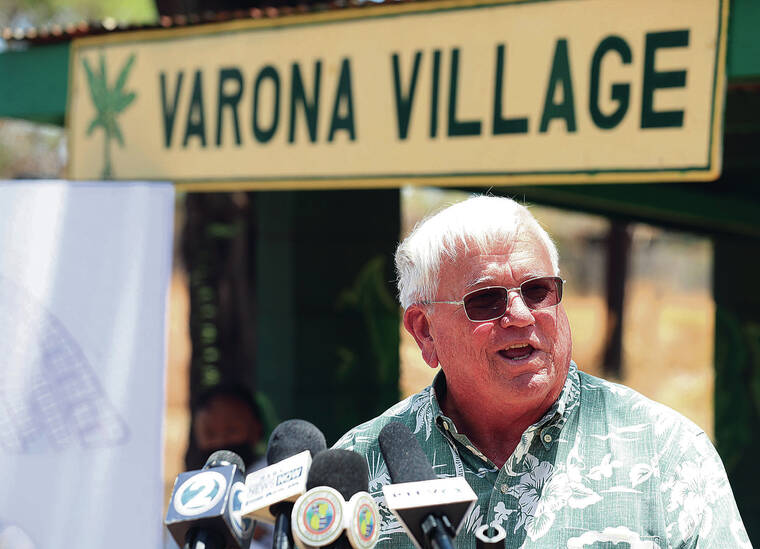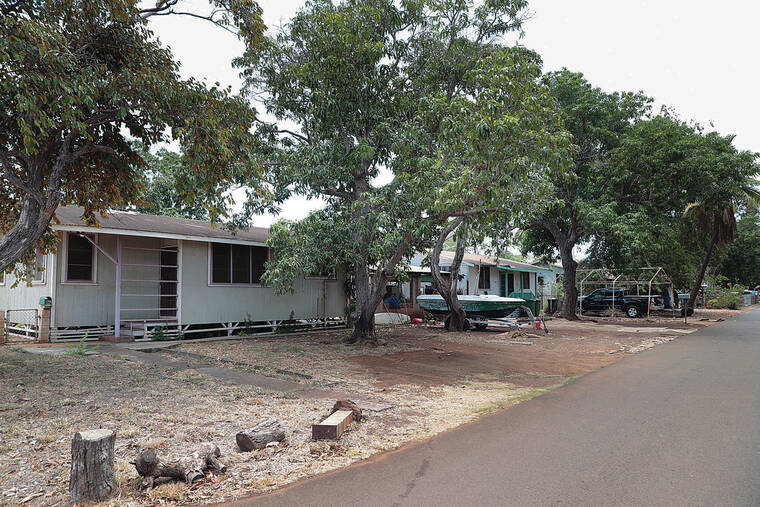Redevelopment to begin on Varona Village

JAMM AQUINO / JAQUINO@STARADVERTISER.COM
Plans are finally moving forward as local developer Peter Savio, above, has partnered with Hawaii Habitat for Humanity to restore Varona Village.

JAMM AQUINO / JAQUINO@STARADVERTISER.COM
Homes along a street in the plantation-era community Tuesday in Ewa Beach.

STAR-ADVERTISER
Chris Hong

JAMM AQUINO / JAQUINO@STARADVERTISER.COM
Honolulu Mayor Rick Blangiardi announced plans Tuesday for redevelopment of Varona Village in Ewa Beach.




Across the street from a green, shaded bus stop along Renton Road in Ewa Beach, 24 acres of aging one-story homes in Varona Village await renewal.
The Ewa plain community — once filled with 93 homes rented by employees of the long-defunct Oahu Sugar’s Ewa Plantation — is being redeveloped by the city in partnership with the Savio Group of Companies and Hawaii Habitat for Humanity Association.
The developer, now called Savio/Hawaii Habitat Varona Village LLC, says it’s working with the city to fulfill a plan nearly 30 years in the making: to provide the Varona Village tenants of record, their families and current Varona Village residents the opportunity to own the homes they live in.
That plan includes new 100% “affordable” housing lots, which will be made available to the community for purchase, with first priority given to Varona Village members, current and former, then to the local community at large, according to the developer.
“Many of these tenants and their families, with connections to Ewa Plantation, poured their blood, sweat and tears into this unique plantation-style community, and we are proud to be able to finally make homeownership a reality for so many,” Mayor Rick Blangiardi said during a Tuesday news conference in the neighborhood. “This is a truly special place deserving of preservation and proper care.”
Others also spoke to the “promise” to redevelop Varona Village, largely consisting of homes built in the early 20th century, prior to 1940.
Don't miss out on what's happening!
Stay in touch with breaking news, as it happens, conveniently in your email inbox. It's FREE!
“So the promise that you keep hearing about is that in 1995 the city took some actions to put this on the Historic Register — last of the Ewa Villages — (with) the intent of transferring the properties to the tenants of record,” Chris Hong, the developer’s project manager, said at the news conference.
Toward that effort, Hong noted, the current project will be broken into two phases.
The first phase will see the renovation or repair of 35 to 40 existing homes to meet minimum health and safety codes for the tenants of record, their families or current occupants. Phase two will be the construction of up to 88 new affordable residential homes, mainly condominiums, as well as one community center, he said.
In addition, the city will work to bring new sewage lines — as most existing homes within the Varona Village community are connected to old septic tank systems — and other roadway and infrastructure improvements to adjacent Renton Road.
“Now we’re at a point where we have a development agreement that was agreed upon,” said Hong, “and we’re closing in on the agreement of sale so that we can fulfill that promise and make the tenants of record homeowners within this property.”
He added as soon the condominium property regime, or CPR, approval process is done, “we’re going to sell the lots as is … to the tenants of record.”
Hong could not give pricing for the proposed for-sale properties. And Hong said he did not know how many original tenants of record — many of whom are in their 90s — remained.
But Hong did say Varona’s tenants of record, including spouses, family members and descendants of sugar plantation workers, would see lots for sale priced at about $100,000.
According to the developer, the tenants of record “can buy the home they occupy or if (a) vacant lot is desired, priority will be based on years of service at Ewa Plantation/Oahu Sugar Company.”
Hong said the timeline to see this project built could occur by early 2025, to be sold off “to the tenants of the record.”
“So as soon as we close on the agreement of sale, then we’ll start with the CPR process,” he said. “And at the same time, knowing that it takes time to financially qualify some of these families, we will be working with lenders to make sure they have financing, and that will be working in parallel with us to do the condominium process.”
In past years the effort to rejuvenate Varona Village, as well as neighboring Ewa Village communities, stalled several times.
As the Honolulu Star-Advertiser reported in October 2020, the original plan, dating back to the early 1980s, involved the city buying 676 homes on 243 acres Campbell Estate leased to Amfac-owned Oahu Sugar. City officials anticipated carrying out the plan in phases over six to eight years, and said affordable sale prices would cover city costs.
An initial phase was completed on Fernandez Village, where 229 homes were improved and sold for $1 plus $5 per square foot of land.
Under then-Mayor Frank Fasi in 1991, a more ambitious “Ewa Villages” master plan was finalized and involved acquiring about 600 acres to preserve Ewa Plantation villages and create new affordable and market-price housing communities along with parks and a municipal golf course to alleviate flooding.
However, village preservation got scaled back to cover only three of the seven untouched plantation communities. To be preserved were Renton, Tenny and Varona Villages, while Mill, Middle, Lower and C villages were razed.
The city completed its purchase in 1992, and home sale prices for plantation workers were estimated at $45,000 to $55,000 without improvements and $110,000 to $130,000 renovated.
Work on all three villages was projected to be done by 1998 under what was being hailed as a national model.
Homes sales began in 1995 at Renton and Tenny villages during the administration of Mayor Jeremy Harris, in which a scandal erupted with city housing official Michael Kahapea convicted of leading a scam to steal $5.6 million from the project.
Work was completed at Renton, also known as Haole Camp, and at Tenny, otherwise known as Japanese Camp, along with Ewa Villages Golf Course, parks and new residential communities.
Yet Varona, also known as Filipino Camp and Banana Camp, got sidestepped as some city officials pushed for demolition because homes were too run down.
And, according to the city, redevelopment efforts for Ewa Villages were nearly complete — except for Varona Village — when the city Department of Housing and Community Development dissolved in 1998.
It wasn’t until 2013, when the City Council convened a Varona Village Working Group, that efforts to rekindle this redevelopment project occurred. The group’s recommendations culminated in a 2017 solicitation seeking a redevelopment partner, the city said.
At Tuesday’s news conference, Blangiardi said completing the Varona Village project was important to his own administration.
“This was 2-1/2 years in the making since we got into office,” the mayor said. “We looked around and said, ‘What are some of the projects that are viable, that should have happened but didn’t happen, and what can we do about it?’ And Varona Village was right at the top of that list.”
———
Star-Advertiser staff writer Andrew Gomes contributed to this report.



